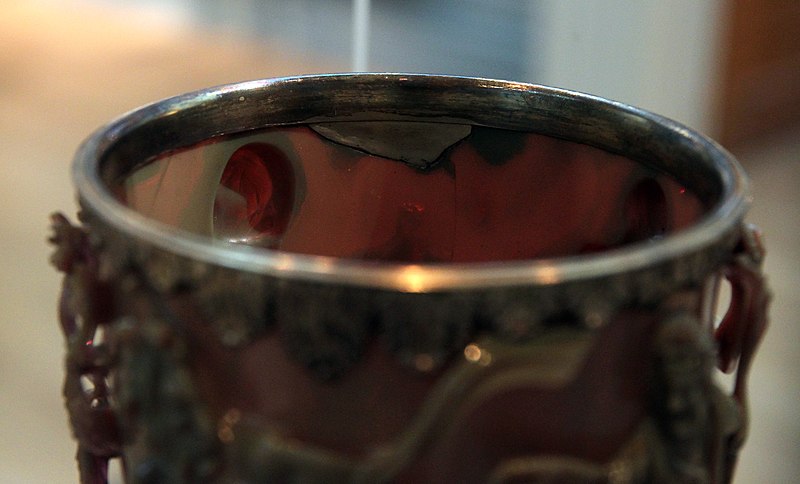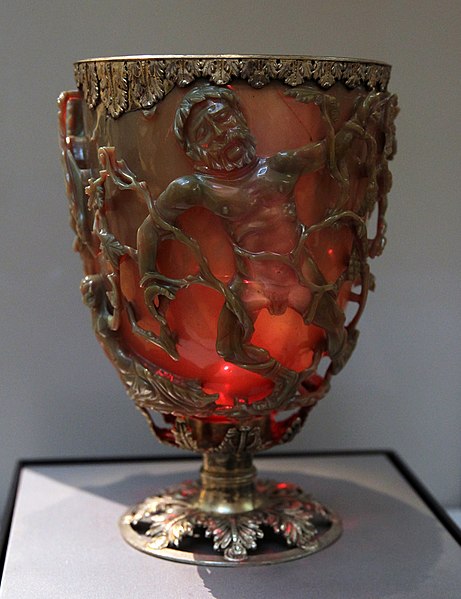The Lycurgus Cup, a remarkable artifact from the 4th century, stands as a captivating example of ancient Roman craftsmanship and ingenuity. Crafted from dichroic glass, the cup changes color when light passes through it, transforming from a deep, opaque green to a glowing, translucent red.
This ancient treasure, depicting the mythical tale of King Lycurgus, bridges the gap between historical art and the advanced material science of its time. Through this article, we aim to shed light on the mysteries of the Lycurgus Cup, exploring its historical significance, artistic beauty, and the scientific principles behind its mesmerizing color-changing effect.
What is the Lycurgus Cup?
The Lycurgus Cup stands as a remarkable piece of ancient Roman artistry, intriguing scholars and enthusiasts alike with its unique properties. This 4th-century glass chalice is not just a marvel for its intricate design, depicting the mythological king Lycurgus entangled in vines, but also for its astonishing ability to change color.
When lit from the front, the cup showcases a jade green hue, but when light shines through it from behind, it transforms into a translucent, deep red. This stunning effect is due to the cup’s composition, which scientists have discovered contains tiny particles of gold and silver – a technique that predates modern nanotechnology by centuries.
What makes the Lycurgus Cup particularly fascinating is its blend of art, mythology, and advanced craftsmanship. The Romans were known for their contributions to architecture and engineering, but the cup reveals their mastery in materials science as well, albeit unknowingly. The precise method of creating such a dichroic glass remains a topic of research and admiration, as it demonstrates a sophisticated understanding of materials that would not be replicated until the modern era.
The cup currently resides in the British Museum, where it continues to attract visitors from around the world. Its allure lies not only in its aesthetic and historical significance but also in the mystery of its creation.
The Lycurgus Cup and Nanotechnology
The Lycurgus Cup unexpectedly links the past to the cutting-edge field of nanotechnology. This connection was unveiled through modern scientific analysis, revealing that the cup’s color-changing properties are due to the presence of gold and silver nanoparticles within the glass. When light passes through, these particles scatter in a way that changes the cup’s color depending on the direction of the light source. This phenomenon, known as dichroism, was achieved by the Romans nearly 1,600 years ago, long before the concept of nanotechnology was even conceived.
The discovery of this ancient technique has sparked considerable interest among scientists and technologists. It demonstrates that the artisans who crafted the Lycurgus Cup had, perhaps unknowingly, utilized what we now understand as nanoscale materials to create a unique visual effect. This insight has prompted researchers to look back to historical artifacts for inspiration, suggesting that the ancients might have been the first to harness the potential of nanomaterials.
Today, the principles observed in the Lycurgus Cup are applied in various modern technologies, including anti-counterfeiting measures, color-changing paints, and advanced optical devices. The cup not only stands as a symbol of ancient artistry and mythological storytelling but also as a bridge to understanding how ancient practices can inform and enhance contemporary scientific and technological innovations.
Conclusion
In conclusion, the Lycurgus Cup is a fascinating artifact that embodies the intersection of history, art, and science. Its ability to change color, thanks to the ancient Roman use of nanotechnology, highlights a sophistication in craftsmanship that challenges our understanding of historical technological capabilities.
This ancient chalice not only captivates the imagination with its mythical depiction and stunning visual effects but also serves as a source of inspiration for modern science. The cup’s unique properties have led to breakthroughs in materials science and have opened up new avenues for research and innovation.


